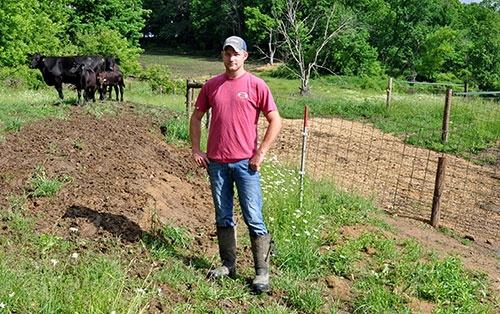You are here
Home ›NRCS helps young Harpers Ferry farmer plan new grazing system

Ryan Collins of Harpers Ferry utilized funding through the Natural Resources Conservation Service’s Environmental Quality Incentives Program (EQIP) to install more than 7,000 feet of permanent, barbed wire fence and about 3,500 feet of high tensile electric fencing throughout pasture on his farm. Collins has 35 cow/calf pairs grazing his 170 acres and worked with the Natural Resources Conservation Service to plan, implement and fund the grazing practices being utilized on his farm. Submitted photo.
by Jason Johnson
Public Affairs Specialist, USDA Natural Resources Conservation Service, Des Moines
Before Allamakee County livestock producer Ryan Collins purchased his own farm in 2011, he knew USDA’s Natural Resources Conservation Service (NRCS) could help him plan a rotational grazing system through previous experiences with the agency on land his family rented.
So, one of his first calls was to the NRCS office in Waukon when he decided to implement a similar grazing system for his herd of cow/calf pairs on his newly-acquired 170-acre farm near Harpers Ferry.
A rotational grazing system - also referred to as prescribed grazing - means dividing pastures into four or more small paddocks with fencing. The animals move from paddock to paddock on a prearranged schedule based on forage availability and livestock nutrition needs.
“We thought the fencing for rotational grazing we installed on that other farm would be a great addition to this farm,” said Collins, a 2009 Iowa State University graduate.
Cattle moved paddock to paddock for the first time in 2015 throughout Collins’ pasture. He said he noticed a lot more grass available than before. “I attribute it to the rotational grazing,” he said. “I like to have plenty of grass. The cows and calves both do well.”
When he originally contacted NRCS for assistance in 2011, Collins assumed he would only be receiving help with fencing for his new grazing system. However, he has worked regularly with NRCS staff - including District Conservationist LuAnn Rolling - to develop and implement a plan that is helping Collins better manage his grasslands, keep cattle healthy and productive, and protect the natural resources on his farm.
“I didn’t realize there were so many practices available for funding through EQIP (Environmental Quality Incentives Program) until I started working with LuAnn,” said Collins.
Administered by NRCS, EQIP provides agricultural producers financial and technical assistance to implement structural and management practices that optimize environmental benefits on working agricultural lands. NRCS provided about $16.4 million to Iowa farmers in fiscal year 2015 to implement conservation practices to improve soil health, protect water quality, and address other resource concerns.
POND ACCESS RAMP
One of the practices Rolling recommended - a limited access ramp for ponds - is now a key component for watering Collins’ cattle. Design of the rotational grazing system called for three of five paddocks to utilize an existing pond for drinking water. To prevent erosion and further pond degradation, Rolling recommended fencing off the pond, but still allow livestock to drink directly from it using a fenced access ramp.
The previous property owner allowed livestock to openly graze with free access to the pond, causing bank erosion and poor water quality. Rolling says livestock should almost always be excluded from streams and ponds. “Allowing unlimited access to water sources like ponds and creeks can be dangerous and unhealthy for animals,” she said. “Cattle can get foot rot and leg injuries. Plus, cattle prefer clean water.”
Rolling says keeping animals out of ponds extends pond life, too, allowing bank vegetation to grow which keeps water cleaner by reducing sediment and nutrient runoff.
The entire access ramp is 40 feet long with a gradual 8:1 slope. Collins hired a contractor who dug out about one foot of sediment from the bottom of the pond where the ramp was installed. The contractor installed geo-textile, covered it with three- to nine-inch rock, and topped that with two- to three-inch rock. The bottom 15’ x 15’ drinking area is covered in water. “The ramp is very solid and stable, and won’t erode,” said Collins.
He said the primary maintenance of the ramp will be reinforcing the fence when necessary, since it is a high intensity area, and keeping the fence free of debris.
OTHER PRACTICES AND MAINTENANCE
As part of the rotational grazing system, Collins installed more than 7,000 feet of permanent barbed wire multi-strand fence and 3,500 feet of permanent high tensile fencing. Since 2012, he has also worked with NRCS to implement the following practices:
• 12 acres of inter-seeded legumes
• four acres of inter-seeded cool season grasses
• 1,000 feet of water pipeline
• two watering facilities with heavy use protection areas.
As a beginning farmer - a group USDA considers historically underserved - Collins received higher payment rates than most farmers for the conservation practices he installed. Iowa NRCS allocates at least 10 percent of EQIP funds to historically underserved farmers annually.
FAMILY FARM UPGRADES
Collins is so pleased with the new conservation practices on his farm that he is working with his father to implement some of the same practices on the family farm, about a mile away. “We are going to convert some cropland to pasture to more easily connect two farms for a rotational grazing system,” he said. “We will be able to move cows through five or six paddocks. That is where all of our cows calve in the spring, so after that area gets beat up it will get more rest now.”
They are also planning to install limited access ramps on livestock watering ponds, as well as two new watering facilities. Rolling says there are seven more limited access ramps scheduled to be completed in Allamakee County this year.
For more information about conservation planning and programs for farms, visit the local NRCS office or go to www.ia.nrcs.usa.gov.

